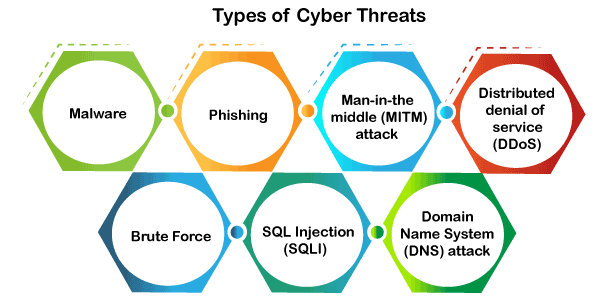Types of cyber security threats
A threat in cybersecurity is a malicious activity by an individual or organization to corrupt or steal data, gain access to a network, or disrupts digital life in general. The cyber community defines the following threats available today:

Malware means malicious software, which is the most common cyber attacking tool. It is used by the cybercriminal or hacker to disrupt or damage a legitimate user's system. The following are the important types of malware created by the hacker:
- Virus: It is a malicious piece of code that spreads from one device to another. It can clean files and spreads throughout a computer system, infecting files, stoles information, or damage device.
- Spyware: It is a software that secretly records information about user activities on their system. For example, spyware could capture credit card details that can be used by the cybercriminals for unauthorized shopping, money withdrawing, etc.
- Trojans: It is a type of malware or code that appears as legitimate software or file to fool us into downloading and running. Its primary purpose is to corrupt or steal data from our device or do other harmful activities on our network.
- Ransomware: It's a piece of software that encrypts a user's files and data on a device, rendering them unusable or erasing. Then, a monetary ransom is demanded by malicious actors for decryption.
- Worms: It is a piece of software that spreads copies of itself from device to device without human interaction. It does not require them to attach themselves to any program to steal or damage the data.
- Adware: It is an advertising software used to spread malware and displays advertisements on our device. It is an unwanted program that is installed without the user's permission. The main objective of this program is to generate revenue for its developer by showing the ads on their browser.
- Botnets: It is a collection of internet-connected malware-infected devices that allow cybercriminals to control them. It enables cybercriminals to get credentials leaks, unauthorized access, and data theft without the user's permission.
A man-in-the-middle attack is a type of cyber threat (a form of eavesdropping attack) in which a cybercriminal intercepts a conversation or data transfer between two individuals. Once the cybercriminal places themselves in the middle of a two-party communication, they seem like genuine participants and can get sensitive information and return different responses. The main objective of this type of attack is to gain access to our business or customer data. For example, a cybercriminal could intercept data passing between the target device and the network on an unprotected Wi-Fi network.
4. Distributed denial of service (DDoS)
It is a type of cyber threat or malicious attempt where cybercriminals disrupt targeted servers, services, or network's regular traffic by fulfilling legitimate requests to the target or its surrounding infrastructure with Internet traffic. Here the requests come from several IP addresses that can make the system unusable, overload their servers, slowing down significantly or temporarily taking them offline, or preventing an organization from carrying out its vital functions.
5. Brute force
A brute force attack is a cryptographic hack that uses a trial-and-error method to guess all possible combinations until the correct information is discovered. Cybercriminals usually use this attack to obtain personal information about targeted passwords, login info, encryption keys, and Personal Identification Numbers (PINS).
6. SQL injection (SQLI)
SQL injection is a common attack that occurs when cybercriminals use malicious SQL scripts for backend database manipulation to access sensitive information. Once the attack is successful, the malicious actor can view, change, or delete sensitive company data, user lists, or private customer details stored in the SQL database.
7. Domain Name System (DNS) attack
A DNS attack is a type of cyberattack in which cyber criminals take advantage of flaws in the Domain Name System to redirect site users to malicious websites (DNS hijacking) and steal data from affected computers. It is a severe cybersecurity risk because the DNS system is an essential element of the internet infrastructure.


Hav to be careful..
ReplyDeleteInformative
ReplyDeleteUseful info
ReplyDeleteVery useful
ReplyDeleteThanks for the info
ReplyDeleteNice one
ReplyDelete